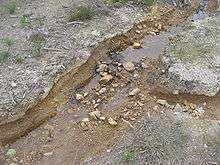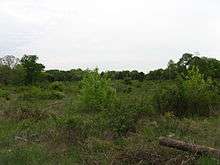Serpentine soil

A serpentine soil is derived from ultramafic rocks, in particular serpentinite, a rock formed by the hydration and metamorphic transformation of ultramafic rock from the Earth's mantle. Serpentinite is composed of the mineral serpentine, but the two terms are often both used to mean the rock, not its mineral composition.
The soils derived from ultramafic bedrock give rise to unusual and sparse associations of edaphic (and often endemic) plants that are tolerant of extreme soil conditions, including:
- low calcium-to-magnesium ratio
- lack of essential nutrients such as nitrogen, potassium, and phosphorus
- high concentrations of nickel and chromium (more common in ultramafic rocks).[1]
The atmosphere is the source of nitrogen, mainly by microbial fixation, in practically all soils. Soils derived from any parent material, including serpentinite, differ greatly in the amounts of plant-available nitrogen in them. Nitrogen spans practically the same range of concentrations in serpentine soils as in most other kinds of soils. The low Ca:Mg ratios is the main plant limiting factor in serpentine soils.
Plants that grow only in serpentine soils are commonly called serpentine endemics.
As ecologic indicator
Excellent examples of serpentine soils and the distinctive ecologic communities associated with them have been described in western North America.[2]
For instance, in areas where these ultramafic rocks are patchy, such as the Klamath Mountains of northern California and southwest Oregon, the areas of serpentine soil can be clearly seen as sparsely covered areas or open forest bounded by closed forest on the non-ultramafic soils.
Botany
Areas of serpentine soil are also home to diverse wildflowers, many of which are rare or endangered species such as Acanthomintha duttonii, Pentachaeta bellidiflora, and Phlox hirsuta. In California, shrubs such as leather oak (Quercus durata) and coast whiteleaf manzanita (Arctostaphylos viscida ssp. pulchella) are typical of serpentine soils.
Parent rock
Serpentine-rich rock or serpentinite has a mottled, greenish-gray color with a waxy feel to it. These rocks form by the reaction of olivine-rich rock, peridotite, with water.
It forms in oceanic crust near the surface of the earth, particularly where water circulates in cooling rock near mid-ocean ridges: masses of the resulting ultramafic rock are found in ophiolites incorporated in continental crust near present and past plate tectonic boundaries.
Distribution
Serpentine soils are widely distributed on Earth, in part mirroring the distribution of ophiolites. Although it covers only about 1 percent of the state's surface, the state rock of California is serpentine. One such area in California is the Edgewood Park and Natural Preserve.[3] Serpentine soils also are present in small but widely distributed areas on the eastern slope of the Appalachian mountains of eastern North America.[4]
Serpentine endemism and bioremediation
The unique plants that survive in serpentine soils have been used in the process of phytoremediation, a type of bioremediation. Because those plants developed specialized adaptations to exist in a metal-saturated environment, they have been used to treat environmental problems by taking up certain heavy metals from polluted soil.[5]
Serpentine barrens

Serpentine barrens are a unique ecoregion found in parts of the United States in small but widely distributed areas of the Appalachian Mountains and the Coast Ranges of California, Oregon, and Washington.[6] The barrens occur on outcrops of altered ultramafic ophiolites.
They are named for minerals of the serpentine group, resulting in serpentine soils, with unusually high concentrations of iron, chromium, nickel and cobalt. Serpentine barrens often consist of grassland or savannas in areas where the climate would normally lead to the growth of forests.[7]
The ecology of serpentine barrens is poorly understood: the evolution of plants adapted to such areas and the relationship between the soil geology and ecology, particularly the ways in which plants handle high concentrations of metals such as nickel, is largely unexplored.[8]
Examples
Soldiers Delight Natural Environmental Area in Baltimore County, Maryland, covers 1,900 acres of serpentine barren. The area has over 38 rare, threatened, or endangered plant species as well as rare insects, rocks and minerals.[9]

Rock Springs Nature Preserve in Lancaster County, Pennsylvania, is a 176-acre (71 ha) property conserved by the Lancaster County Conservancy that is a prime example of a serpentine barren. It was originally a grassland, but fire suppression led to the conversion of the area to forest. This barren contains the rare serpentine aster, as well as a number of rare species of moth and skippers.[10]
In Chester County, Pennsylvania, the Nottingham Park Serpentine Barrens was recommended by UMCES as deserving of National Natural Landmark designation, on numerous grounds, including supporting a number of rare and endemic species, an intact population of pitch pine, and also the site having historic significance.[7]
See also
References
- ↑ Chiarucci, A.; A.J.M. Baker (April 2007). "Advances in the ecology of serpentine soils". Plant Soil. Springer Netherlands. 293: 1–2. doi:10.1007/s11104-007-9268-7.
- ↑ Alexander, E. B.; Coleman, R. G.; Keeler-Wolf, T.; Harrison, S. (2007). Serpentine Geoecology of Western North America: Geology, Soils, and Vegetation. New York: Oxford University Press. ISBN 0-19-516508-X.
- ↑ San Mateo County - Parks Department - - Edgewood Park & Natural Preserve
- ↑ Dann, Kevin T. (1988). Traces on the Appalachians: A Natural History of Serpentine in Eastern North America. New Brunswick: Rutgers University Press. ISBN 0-8135-1323-5.
- ↑ NATO Advanced Study Institute on Phytoremediation of Metal-Contaminated Soils, Morel, J.-L., Echevarria, G., & Goncharova, N. (2006). Phytoremediation of metal-contaminated soils. NATO science series, v. 68. Dordrecht: Springer.
- ↑ Anderson, Roger C., et al., Savannas, Barrens, and Rock Outcrop Plant Communities of North America, Ch. 19, Cambridge University Press, 1999, ISBN 0-521-57322-X
- 1 2 "Evaluation of the Nottingham Park Serpentine Barrens", UMCES-AL, Retrieved May 10, 2009.
- ↑ Rajakaruna, Nishanta; Harris, Tanner B.; Alexander, Earl B. (2009). "Serpentine Geoecology of Eastern North America: A Review". Rhodora. 111 (945): 21–108. doi:10.3119/07-23.1.
- ↑ http://www.dnr.state.md.us/publiclands/central/soldiersdelight.asp
- ↑ "Rock Springs Nature Preserve", Lancaster County Conservancy Website, Retrieved May 10, 2009.